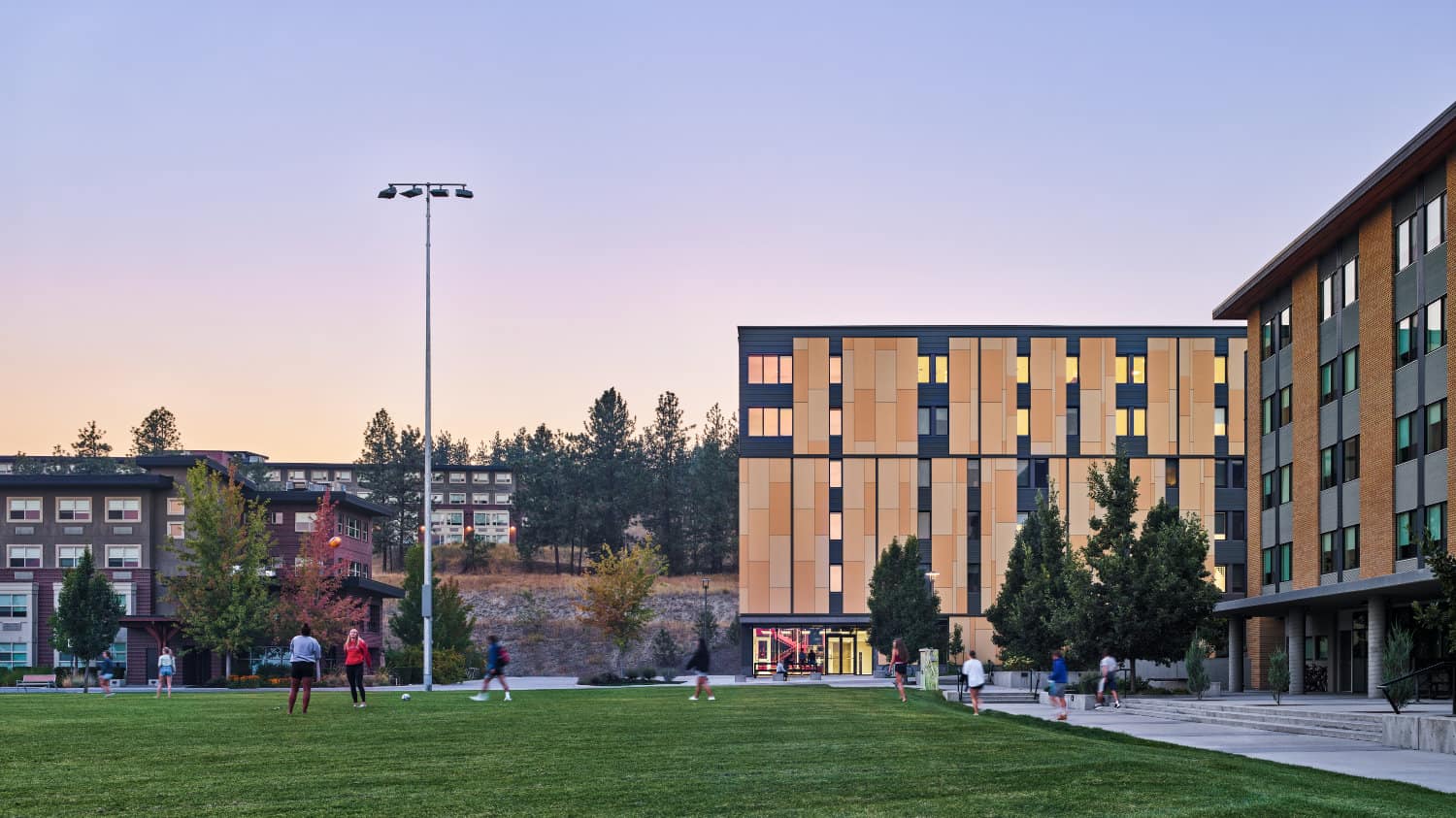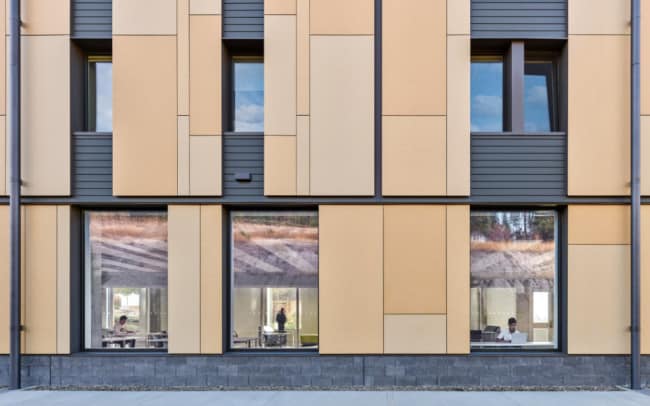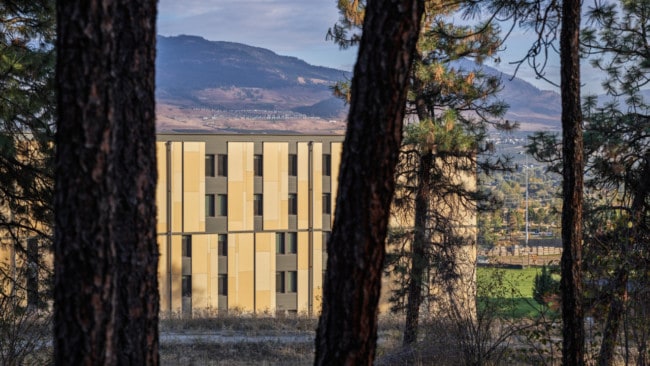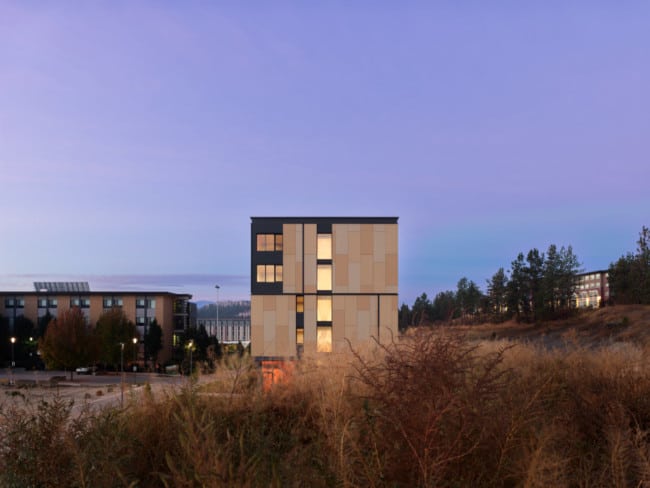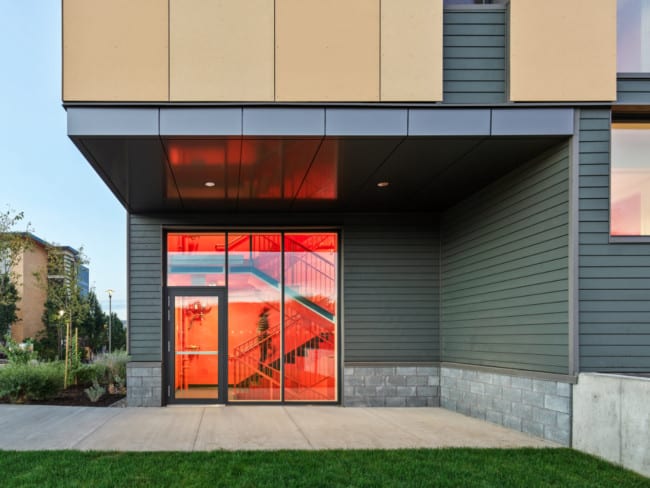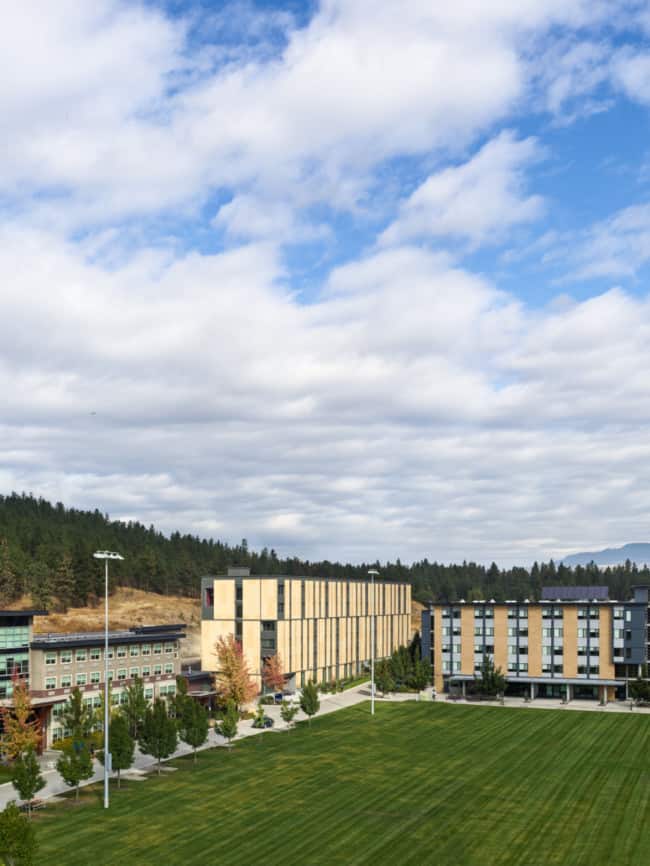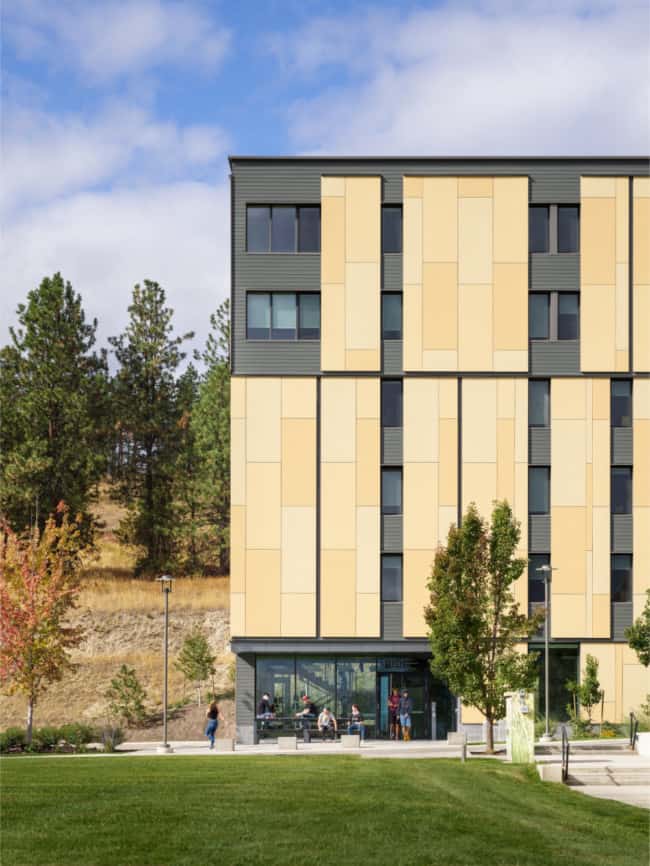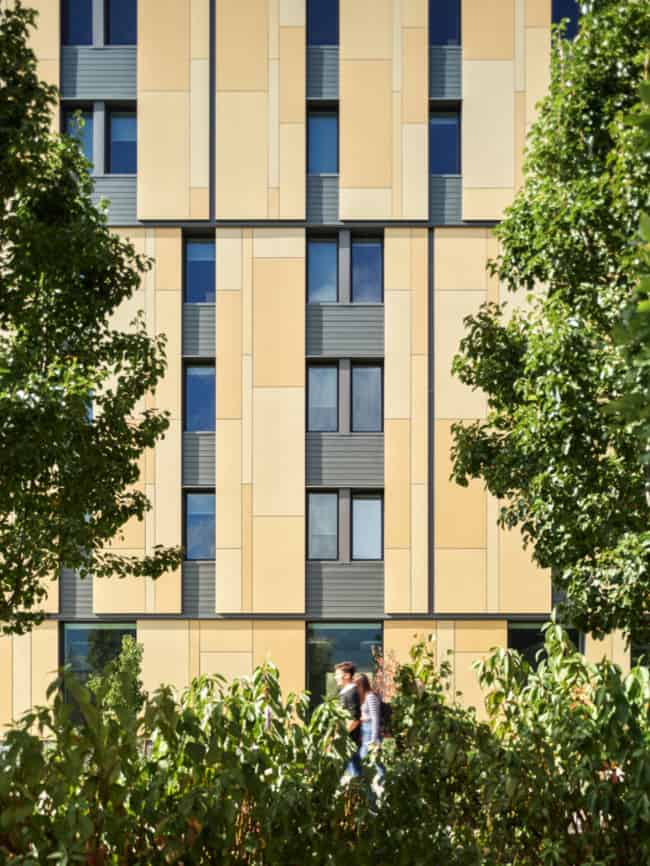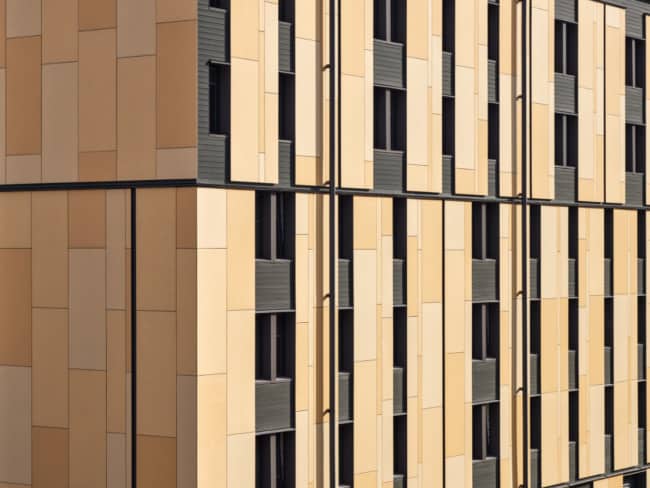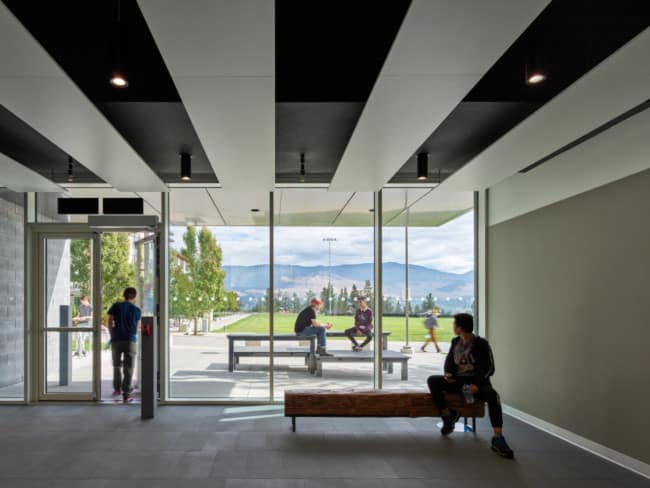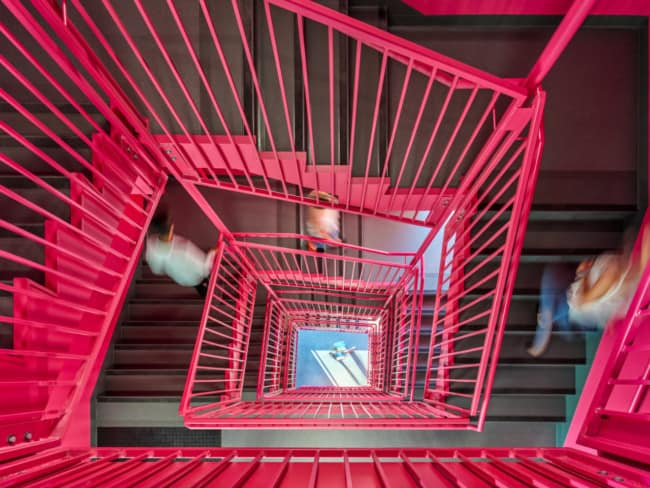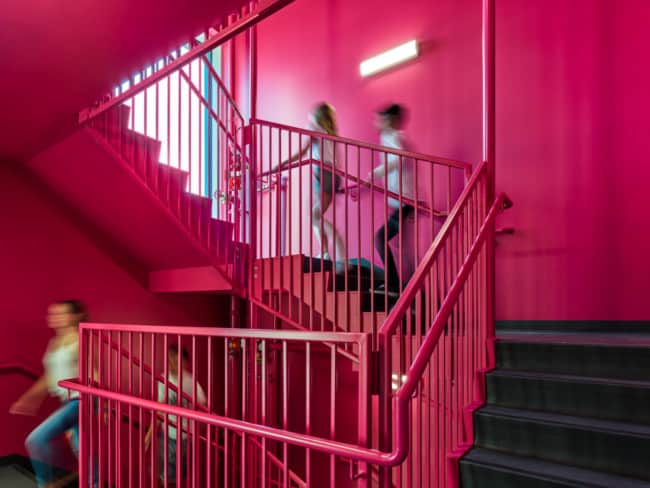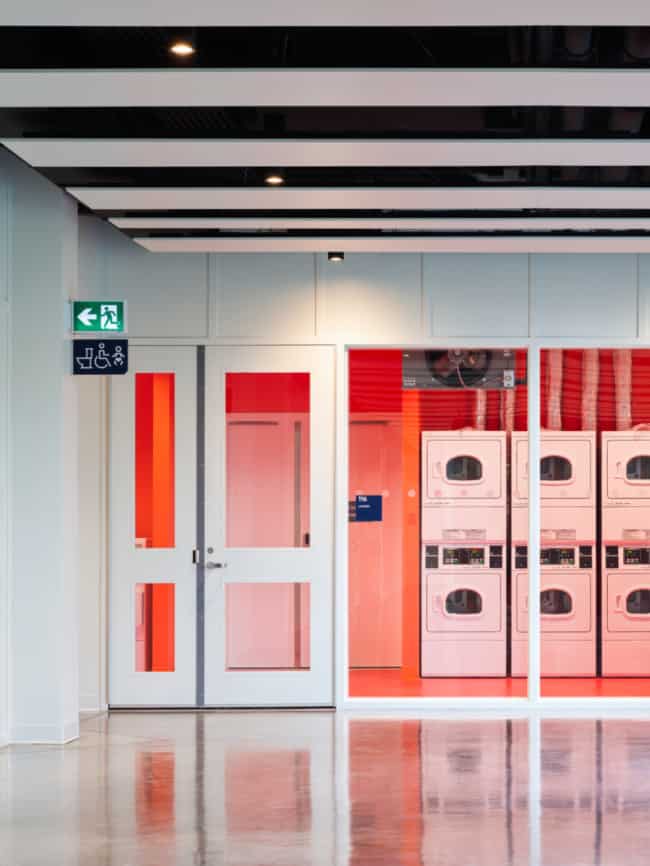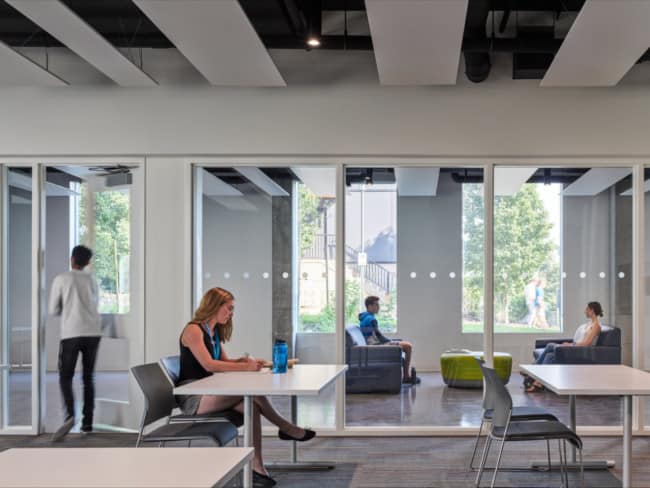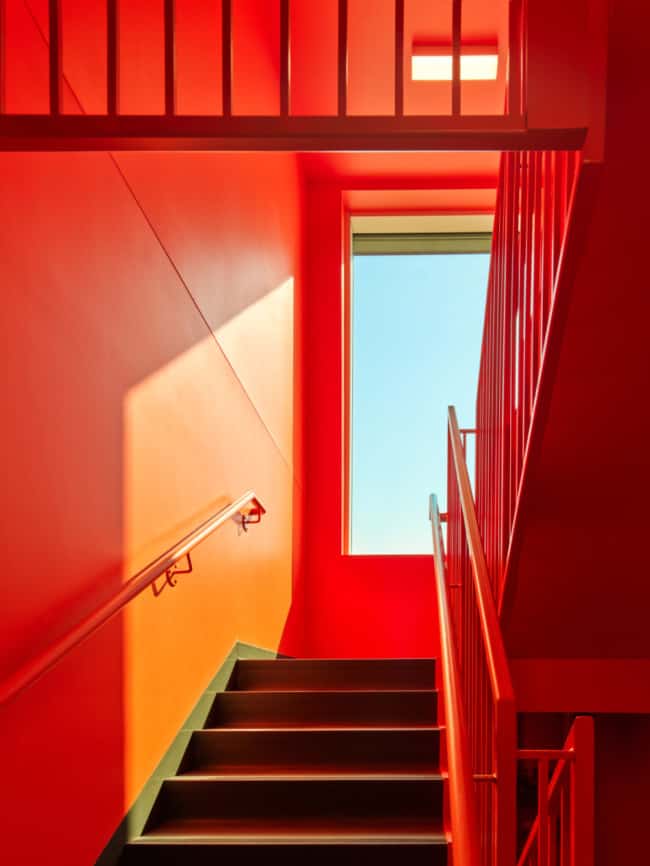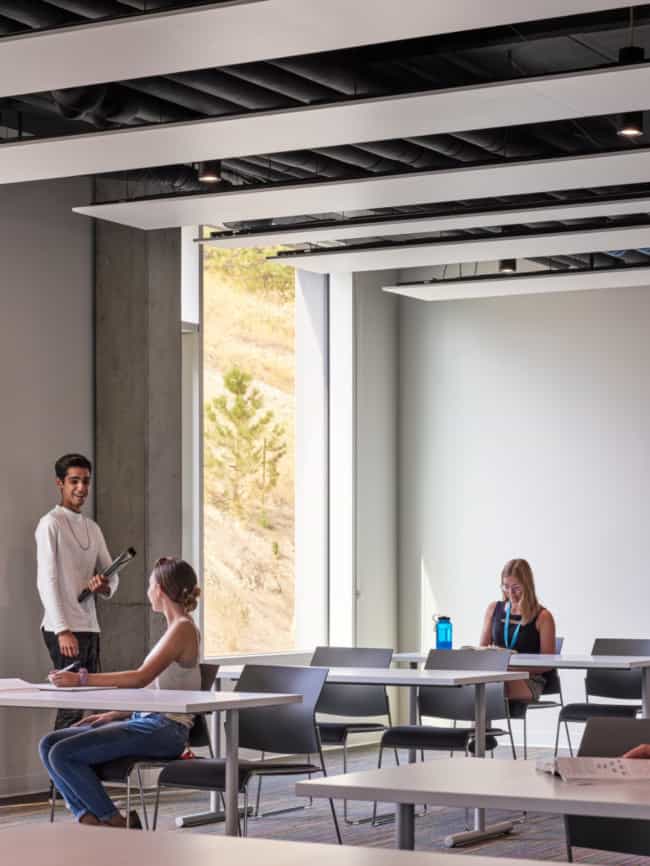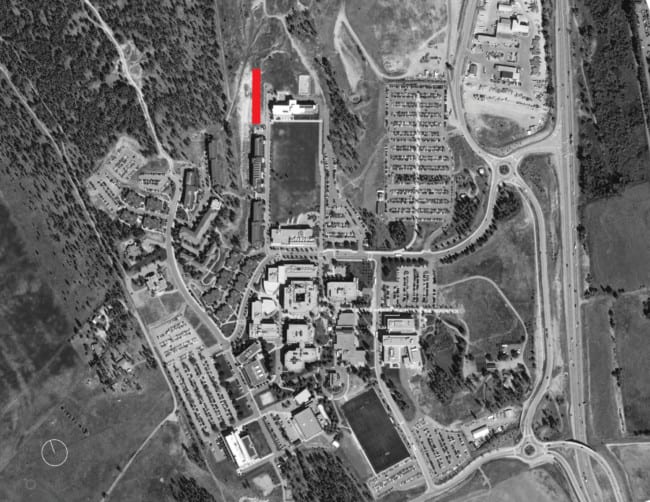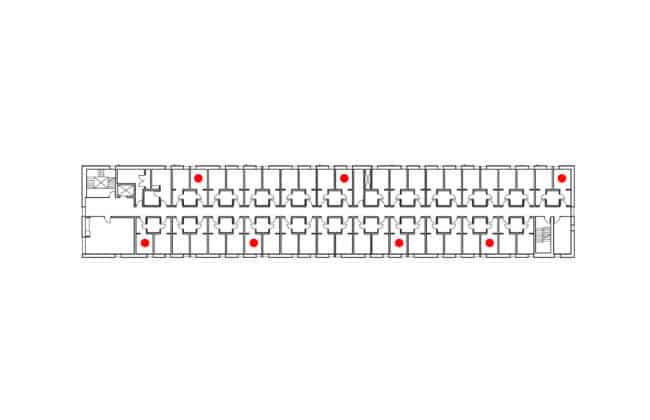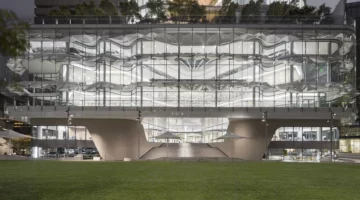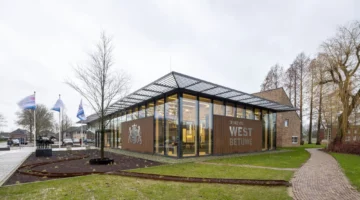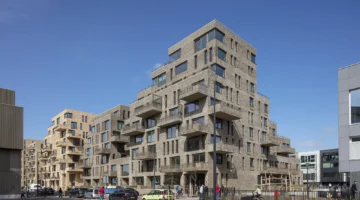Defined by sun floods, through views, and candy-coloured stairwells, the new, six-storey Passive House Skeena residence provides 220 modified traditional bedrooms and support amenities. Completing an ensemble of buildings surrounding the Commons lawn at UBC Okanagan campus in Kelowna, BC, the residence provides easy access to outdoor green space for picnics, fitness, or just hanging around.
More than with conventional building methodologies, an integrated design process is vital to achieving Passive House. A conventional design process begins with broad strokes and becomes further refined with each iteration. With Passive House, however, details rule: even fasteners become an essential element because of their ability to conduct heat. Designing the details in preliminary phases allows for accurate energy modeling.
The Passive House process accelerates decision-making and is heavily weighted toward preliminary design with significant time and cost savings achieved by working through problems in the beginning. Energy invested early in the design pays off over the lifetime of the building. To demonstrate the efficiency of the residence: at the coldest point in the year, more than ¼ of the heat required for the building is supplied by student body heat.

Passive House Skeena Residence - Brief
Skeena Residence is the first Passive House dormitory in Canada and the second in North America. It will be part of UBCO’s Living Laboratory initiative. As one of several wood frame dormitories on campus, it creates a unique opportunity for studying Passive House performance in Canada. The building has been fitted with a comprehensive monitoring system which will gather data to compare Skeena’s energy use and occupant comfort with neighbouring buildings built to LEED Gold and BC Building code standards.
The first cohort of students who are living in the building will complete a post-occupancy survey at the end of the school year which will be added to the study. Every year 220 university students will call Skeena Residence home and become familiar with the advantages of Passive House and act as advocates for low energy living.
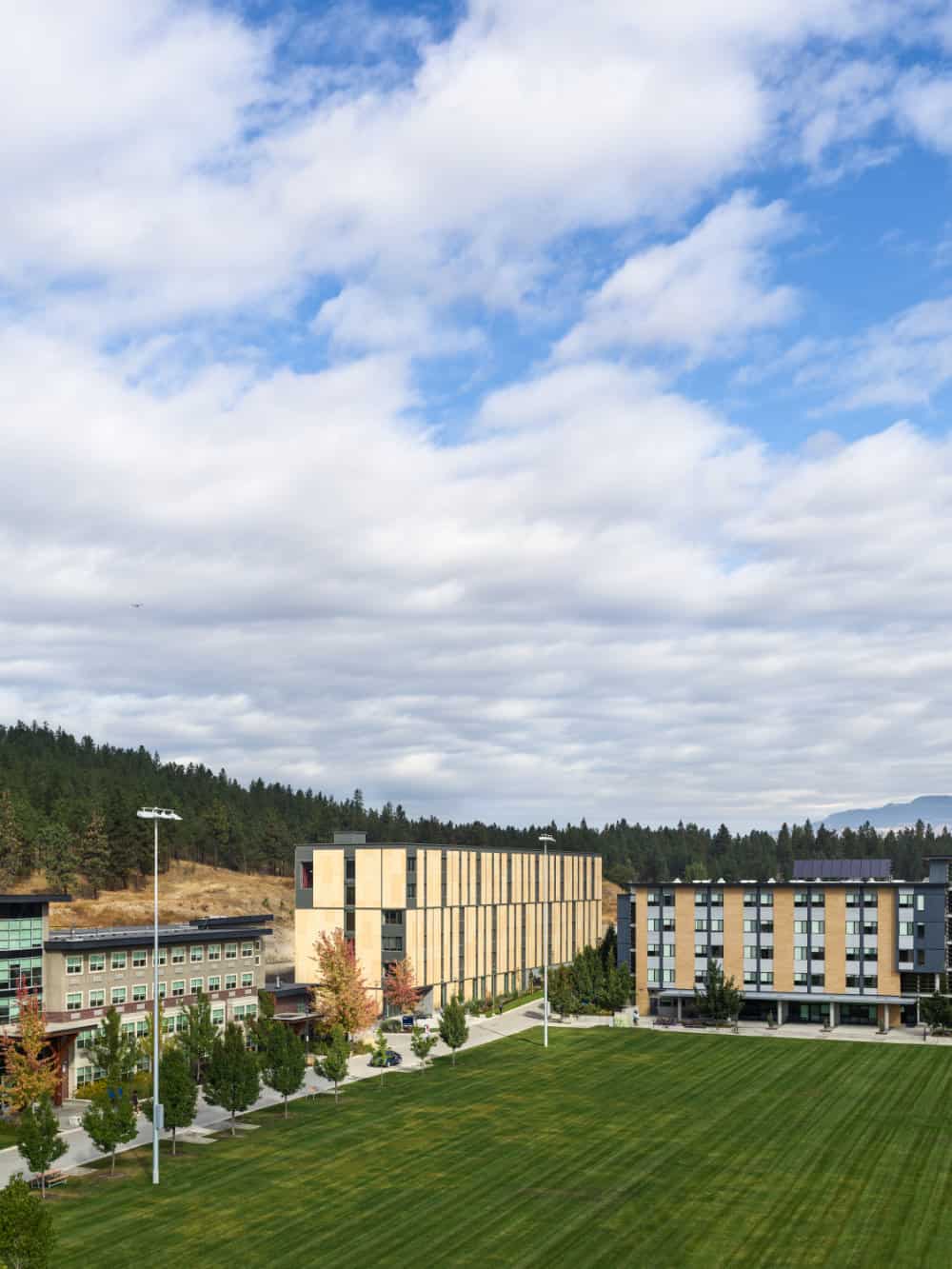
Key Challenges
- 1The decision to pursue Passive House would not be made until after the project was designed and the schedule could not be interrupted: PUBLIC’s solution was to design the Passive House layer and systems like a jacket that could simply be taken off within hiccup.
- Passive House buildings require simple forms for energy efficiency. Skeena was built into a non–Passive House context, which set up unrealistic design expectations: To counter these expectations, our team allowed for time to educate and inform the client and user groups.
- Construction of the wall assembly is new—and therefore challenging—to many tradespeople: To offset this learning curve, RDH, the envelope consultant offered onsite workshops focused on Passive House construction.
- Achieving Passive House for Skeena Residence was complicated by the northern desert climatic of the Okanagan region and the student residence typology, which has higher population density; greater density of appliances (fridges, hair dryers, and computers) that creates an enormous plug load, or electrical draw; and much higher humidity than typical multi-family residential. To combat these factors, Skeena focused on insulation, airtightness, and moisture control. For example, air circulation is completely renewed every three hours via highly efficient mechanical systems, thus warding off the threat of mold. Despite these complexities, Skeena Residence was delivered ahead of schedule, under budget, and during a pandemic.
- Some key components of Passive House building have long-lead times. To avoid schedule delays, pre-tender some of the key components such as HRV units and triple-glazed windows.

Sustainability Features
Water Conservation
Water conservation and management is achieved through:
- Achieving a Minimum Indoor Water Use Reduction of 35% based on LEEDv4 indoor water use credit calculations).
- Installing low-flow plumbing fixtures including toilets, showers, urinals and sinks.
- Favouring native and adapted plants for landscape in order to reduce irrigation needs. Providing deep beds to absorb rainwater. Achieving a minimum Outdoor Water Use Reduction of 50% (based on LEEDv4 outdoor water use credit calculation option 2.
- Use of efficient irrigation systems with smart irrigation controllers.
- Rainwater management adheres to the UBCO Integrated Rainwater Management Plan.
Operating Energy Present and Future
Skeena’s annual energy consumption for the building is 70 kWh/m2 per year. This includes a heating demand of just 7.1 kWh/m2 per year, which allows the building to provide heating, cooling and domestic hot water without a fossil fuel (e.g. natural gas) connection. The building is not connected to the campus district heating system as this uses a significant amount of natural gas in its heat generation. Skeena Residence is a standalone electric-based system and utilises electric heat pump technologies for heating and cooling.
The result is a Greenhouse Gas Intensity (GHGI) of just 0.66 kgCO2eq/m2 per year. This performance is a function of the ‘fabric first’ approach of the Passive House standard (airtightness, super-insulation, minimal thermal bridging, triple-glazing etc.) combined with the efficiency of the mechanical design (ventilation heat recovery, heat pumps etc.).
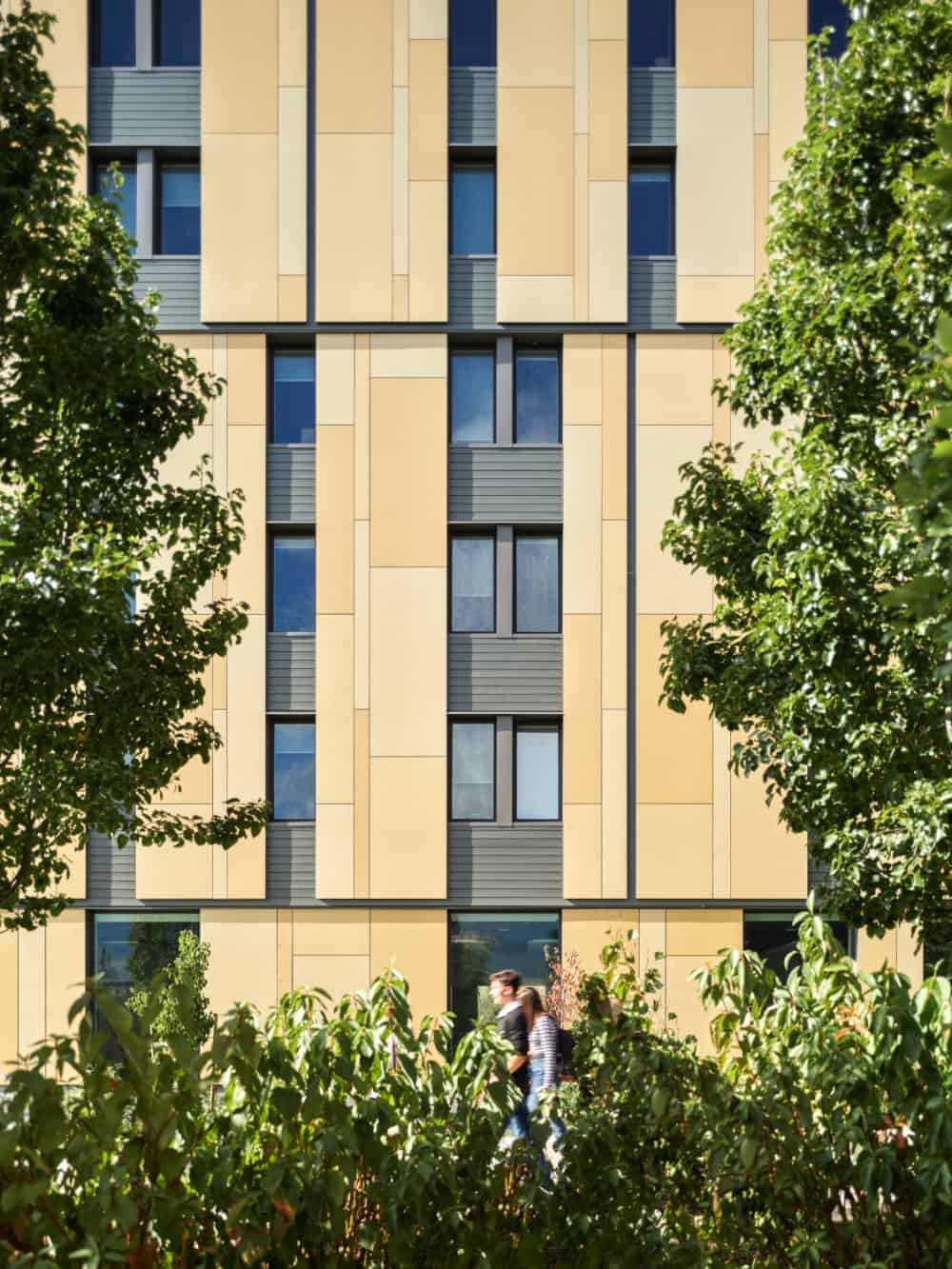
Materials and Resources
The Passive House standard places equal emphasis on occupant comfort and energy-efficiency. The materials specified for both the building envelope and interior finishes were carefully evaluated during design. The PHPP energy model quantified not just building energy use but also thermal comfort to ensure the building envelope creates a comfortable indoor environment free from drafts and cold surfaces. This led to the specification of triple pane glazing in highly-insulated frames as well as a continuous 8” thick blanket of mineral wool insulation around the building. A super insulated roof (approx. R100) further minimizes heat loss from the building.
The exceptional airtightness of the building and the continuous wall and roof insulation greatly reduces the risk of air leakage and condensation in the structural assemblies of the building which should increase the durability and service life of the structure. The structure of the building is mainly light wood framing with a resulting saving in embodied energy over alternate materials like structural steel or concrete.
Low-VOC paint and floor finishes are specified throughout the interior of the building.
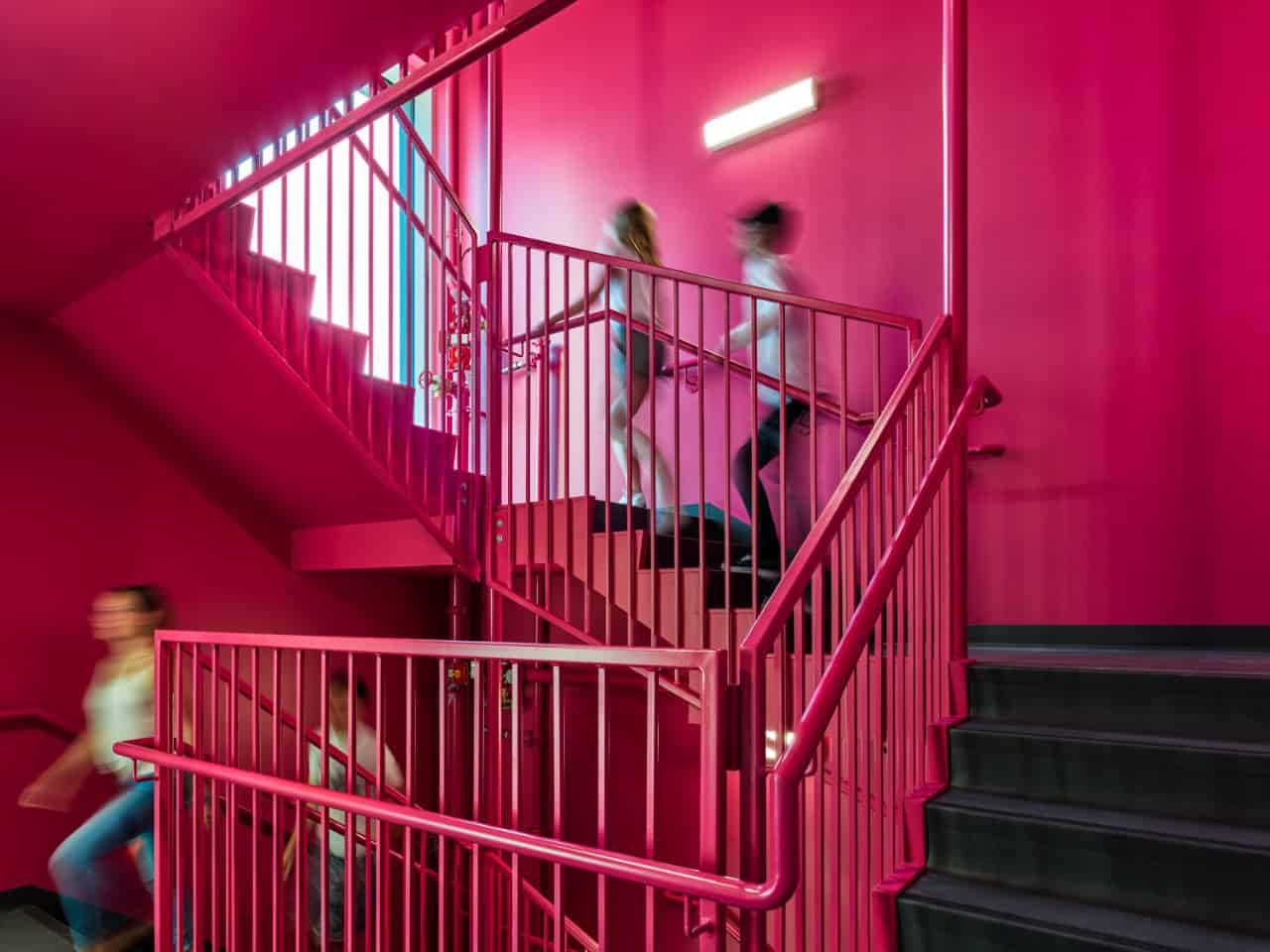
Building Life Cycle Considerations
The designers worked closely with the housing operations team to ensure durability and deconstructability. Short life span elements in student housing were planning for easy replacement. The sequencing of washroom construction, in particular, was carefully considered so that countertops and shower liners could be removed without damaging adjacent wall and floor finishes.
An advantage of PH building is that mechanical systems are located within the thermal envelope and highly insulated to minimize thermal bridging and damage due to condensation. Medium and long service life elements in the building envelope system were sequenced and installed with exposed fasteners to permit disassembly without extensive deconstruction. Long service life elements such as the structure are completely enveloped in exterior insulation. No movement or degradation from thermal bridging is possible. Finally, areas prone to mechanical and moisture damage such as grade to wall transitions are thermally broken masonry units for maximum durability.
Education and Information Sharing
Located between typologically identical buildings designed to building code minimums and LEED Gold levels, Skeena Residence presents a unique opportunity for understanding PH buildings. The building has been fitted with a comprehensive measurement system that will gather data for an ongoing research project to compare Skeena’s energy use and occupant comfort. In addition, every year students provide post-occupancy surveys, a qualitative assessment to complement the quantitative data. Red dots indicate the location of sensors that collect research data.
The project team have presented the Skeena Residence story at the Passive House Canada Conference, EcoCity World Summit, WoodTALKS at the Global Buyer’s Mission, and ZBex, at UBC Okanagan won the Net-Zero Energy-Ready (NZER) Challenge, a provincial CleanBC incentive program aimed at the celebration and promotion of innovative and energy-efficient projects.
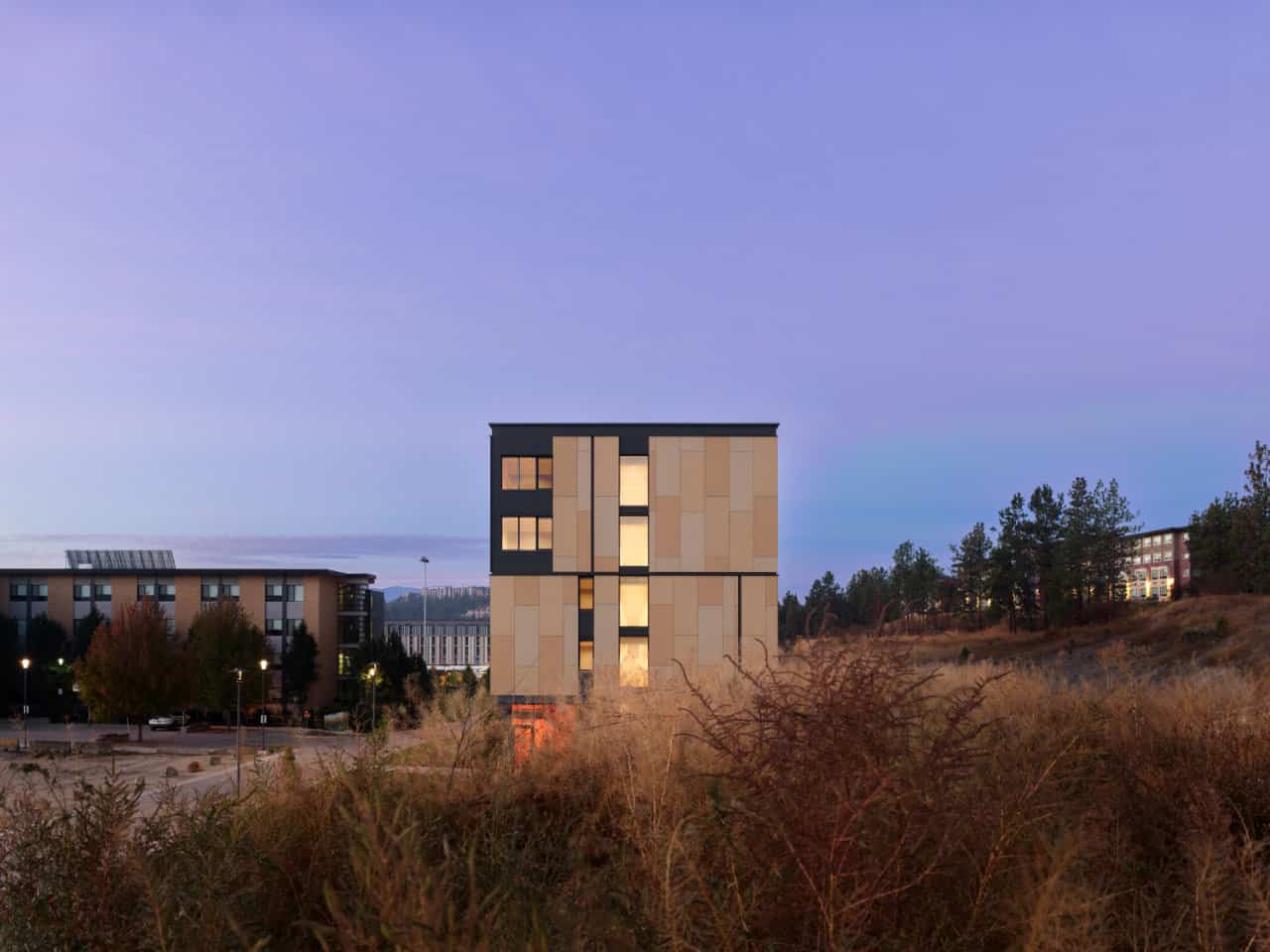
Building Methods
Design decisions are also swayed by other practicalities such as standard and locally available materials and techniques. The building is 80% wood frame with some concrete on the ground floor. A wood structure was chosen for its inherent insulative properties as well as its ready availability and ease of construction.
About the Client
To meet its green house gas reduction targets and contribute to its Living Lab initiative, the University of British Columbia (UBC) asked the project team to design Skeena Residence to meet Passive House (PH) certification. PH is a relatively new certification for midrise buildings in Canada. Currently there are few certified multiunit residential buildings and no certified student residences. The university owns and operates approximately 15,000 beds of student accommodation and is an international leader in post-secondary education.
UBC recently leveraged reputation by building the Brock Commons heavy timber tower which has contributed to the acceleration of tall timber high rises internationally. A PH student residence is another opportunity for the university to accelerate the adoption of the standard. Every year 220 students will live in Skeena Residence and understand the numerous benefits of a PH environment.
